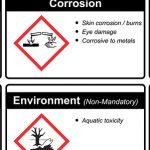GHS Label Requirements
By: Alison Senyi, SENIOR PRODUCT SAFETY SPECIALIST, email
What is GHS?
GHS stands for the Globally Harmonized System of Classification and Labelling of Chemicals. This was introduced by the United Nations (UN) as a way to standardize the classification and labelling of chemical products worldwide. GHS also helps to align the labelling requirements such as signal words and precautionary statements for hazardous products.
What information is required on a GHS label?
It is the supplier’s responsibility to ensure that their hazardous products are correctly labelled before they reach the customer. Employers are responsible for ensuring that hazardous products being used in the workplace are properly labelled.
GHS labels require six elements in order to be compliant. These include the following:
- Product Name or Identifier – this includes the chemical name, generic name, or trade name of the product. The product name on the label must match the name on the corresponding safety data sheet (SDS).
- Hazard Pictograms – these symbols identify the hazards of the product. GHS pictograms are divided into Physical, Health, and Environmental hazards. A single GHS pictogram can be used for multiple hazard classifications.
- Signal Word – used to inform the user of the level of hazard and degree of severity. The two signal words are ‘Danger’ and ‘Warning.’ Danger is used for higher risk hazards, whereas Warning is for hazards that are less severe. There are some hazard classes that do not have an associated signal word.
- Hazard Statements – these phrases describe the nature of the hazard. The statement helps to describe the category of hazard. Hazard statements are short descriptions, that briefly explain the hazards associated with the product.
- Precautionary Statements – phrases that describe the measures that should be taken to prevent adverse effects from exposure to the product, or that could result from improper storage and handling of the product. Examples of precautionary statements include first aid measures, personal protective equipment (PPE), emergency measures that should be followed, storage and handling requirements for the product, fire-fighting measures, etc. Precautionary statements should match the level of hazard of the product classifications. The five types of precautionary statements include: General; Prevention; Response (which includes first aid); Storage; and Disposal.
- Manufacturer / Supplier Information – this shows the company name, address, and telephone number. This section should include the contact information for a Canadian address.
Supplemental label information might also be required based on the classification and nature of the product. For example, if the product is classified in the Acute Toxicity category, then the percent of unknown toxicity for that route must be indicated on the label. This applies to percentages that are higher than or equal to 1% in the overall product.
This section may also list any hazards not otherwise classified. This is when the GHS hazard category has not yet been adopted by GHS, or if the concentration limit falls below the cut-off value for that class.
Other GHS Label Requirements
It is important to note that in order to be compliant with the official language requirements for Canada, the GHS label must be in both languages (English and French). They can be bilingual (using one label), or there can be two separate labels (one in English and one in French).
GHS labels must be easy to read using a font size that would not normally require the use of corrective glasses. The label itself should be in good condition, and displayed on the container in an area that is clearly legible and easy to identify. Labels require the signal word, pictogram(s), and hazard statements to be grouped together. And all label elements should not be contradicting other information on the product container.
Labels are required to be updated within 180 days of the supplier being made aware of any new information and revised data of the product. All relevant product labels must then be updated with the new info.
How can Dell Tech help with my GHS labelling requirement needs?
If you would like further information on the GHS labelling requirements for Canada and the US, please contact us. We’d be happy to review your product information and help determine the hazard classes associated with your product(s), and what label elements are required in order for you to be complaint. Our team also reviews safety data sheets, or if you have a new product we can author one for you.





